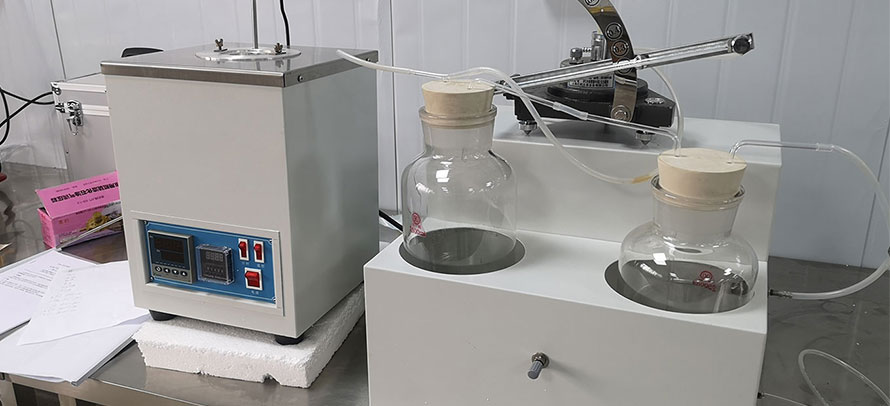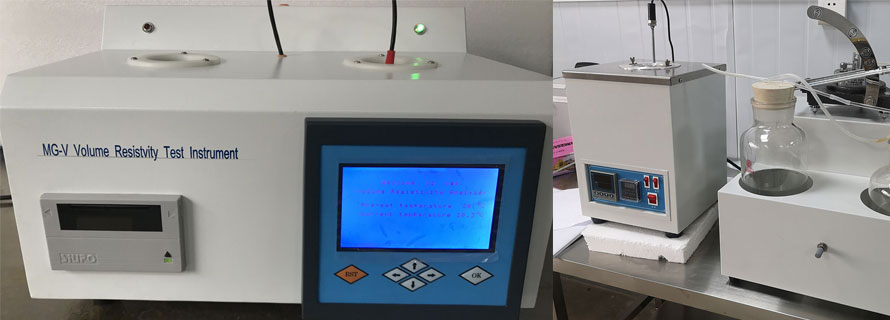9. Procedure (Manual)
9.1 Using a graduated cylinder and taking care to avoid wetting the cup above the final liquid level, measure 50 more or less 0.5 mL of the sample into the cup, both the sample and graduated cylinder being precooled, when necessary, so that the specimen temperature at the time of measurement will be 27 more or less 5°C (80 more or less 10°F) or at least 10°C (18°F) below the expected flash point, whichever is lower. It is essential that the sample temperature be maintained at least 10°C (18°F) below the expected flash point during the transfers from the sample container to the cylinder and from the cylinder to the test cup. Destroy air bubbles on the surface of the specimens by use of knife point or other suitable device. Wipe the inside of the cover with a clean cloth or absorbent tissue paper; then attach the cover, with the temperature measuring device in place, to the bath collar.
9.2 Light the test flame, when used, adjusting it to the size of the small bead on the cover. Operate the mechanism on the cover in such a manner as to introduce the ignition source into the vapor space of the cup, and immediately bring it up again. The time consumed for the full operation should be 1 s, allowing equal time periods for the introduction and return. Avoid any hesitation in the operation of depressing and raising the ignition source. When a flash is observed on the initial operation of the mechanism, discontinue the test and discard the result. In this case, a fresh sample shall be cooled an additional 10°C (18°F), below the original specimen installation temperature.
9.2.1 Exercise care when using a test flame, if the flame is extinguished it cannot ignite the specimen and the gas entering the vapor space can influence the result. When the flame is prematurely extinguished the test shall be discontinued and any result discarded.
9.3 Flash Points Below 60°C (140°F) - When the flash point of the sample is known to be below 60°C (140°F), apply and adjust the heat so that the temperature of the portion will rise at a rate of 1°C (2°F)/min 6 6 s. When the temperature of the specimen in the test cup is 5°C (10°F) below its expected flash point, apply the ignition source in the manner just described in 9.2 and repeat the application of the ignition source after each 0.5°C (1°F) rise in temperature of the specimen.
9.4 Flash Points at 60°C (140°F) or Above - If the flash point of the sample is known to be 60°C (140°F) or higher, apply and adjust the heat so that the temperature of the specimen will rise at a rate of 3°C (5°F)/min 6 6 s. When the temperature of the specimen in the test cup is 5°C (10°F) below its expected flash point, apply the ignition source in the manner just described in 9.2 and repeat the application of the ignition source each 1°C (2°F) rise in temperature of the specimen.
9.5 When the application of the ignition source causes a distinct flash in the interior of the cup, as defined in 3.1.1, observe and record the temperature of the specimen as the flash point. Do not confuse the true flash with the bluish halo that sometimes surrounds the ignition source during applications immediately preceding the actual flash. (Warning - For certain mixtures containing halogenated hydrocarbons, such as, methylene chloride or trichloroethylene, no distinct flash, as defined, is observed. Instead a significant enlargement of the test flame (not halo effect) and change in color of the test flame from blue to yellowish-orange occurs. Continued heating and testing of these samples above ambient temperature can result in significant burning of vapors outside the test cup, and can be a potential fire hazard. See Appendix X1 and Appendix X2 for more information.)
9.6 Discontinue the test and remove the source of heat. Lift the lid and wipe the temperature measuring device bulb. Remove the test cup, empty, and wipe dry.
9.7 If, at any time between the first introduction of the ignition source and the observation of the flash point, the rise in temperature of the specimen is not within the specified rate, discontinue the test, discard the result and repeat the test, adjusting the source of heat to secure the proper rate of temperature rise, or using a modified "expected flash point", or both, as required.
9.8 Never make a repeat test on the same specimen of sample; always take fresh specimen of sample for each test.

